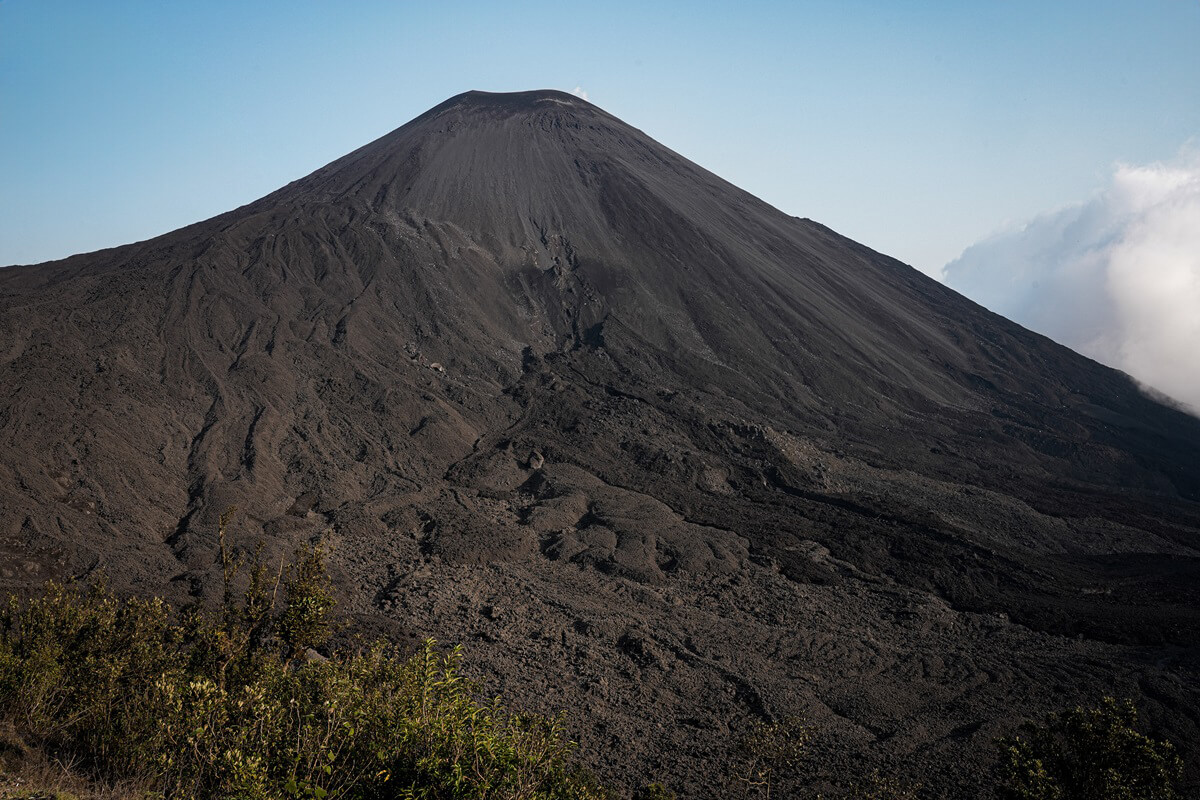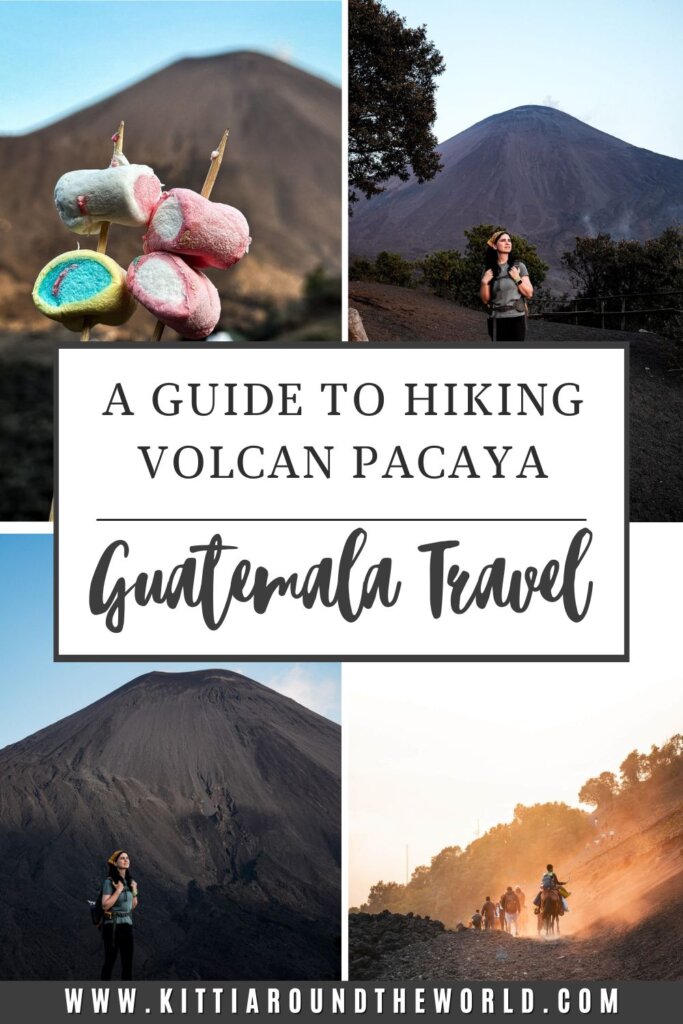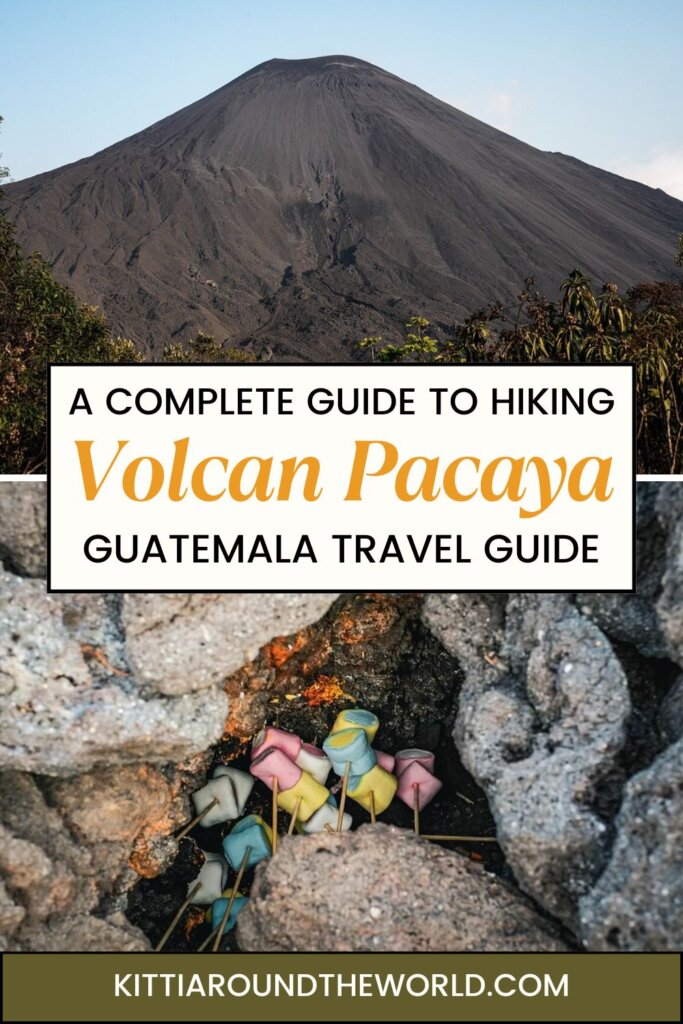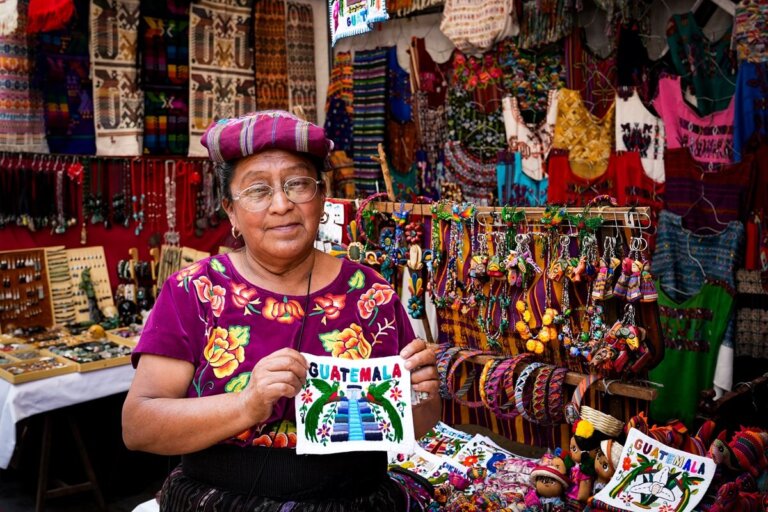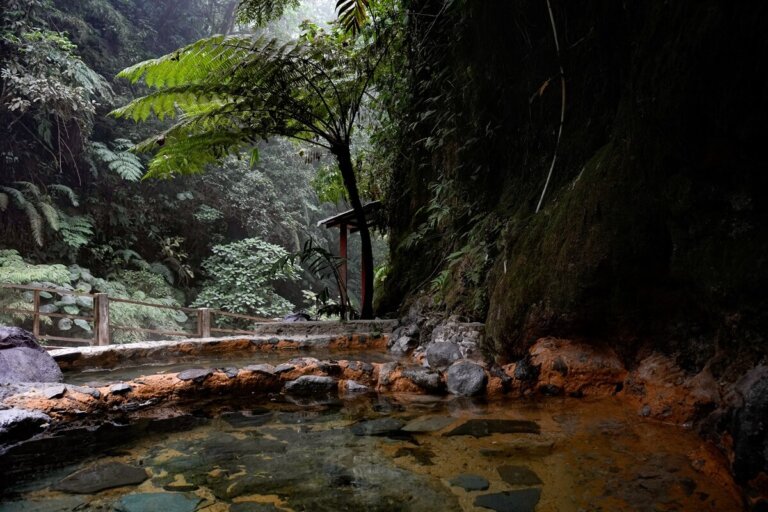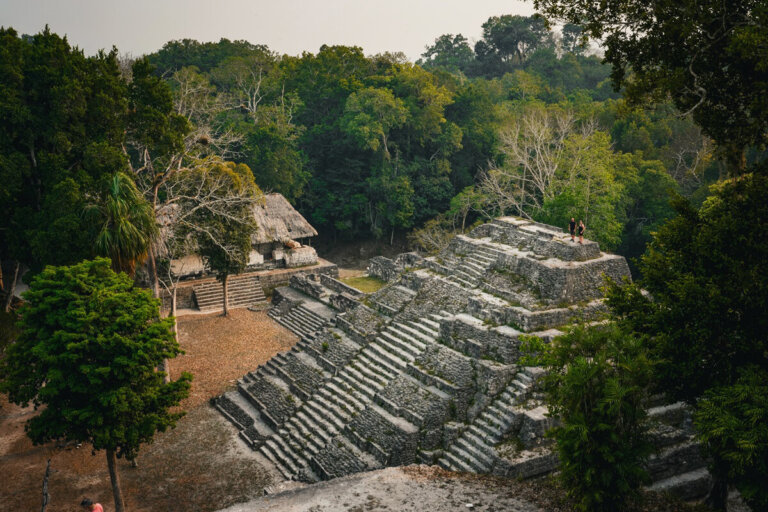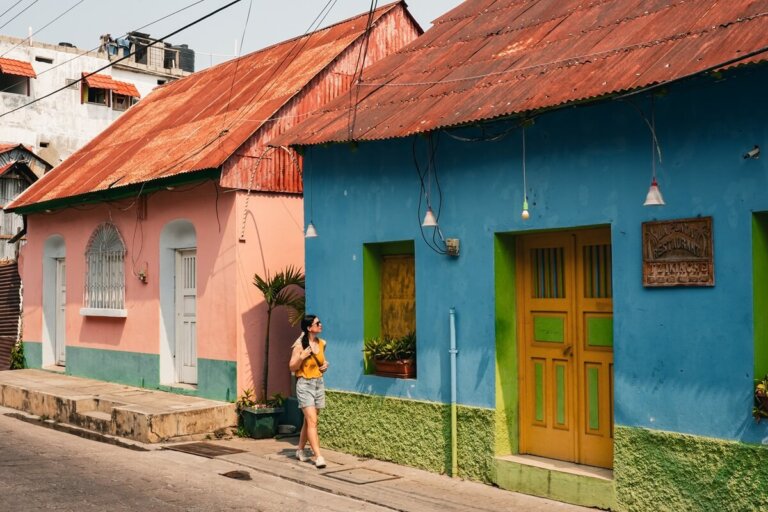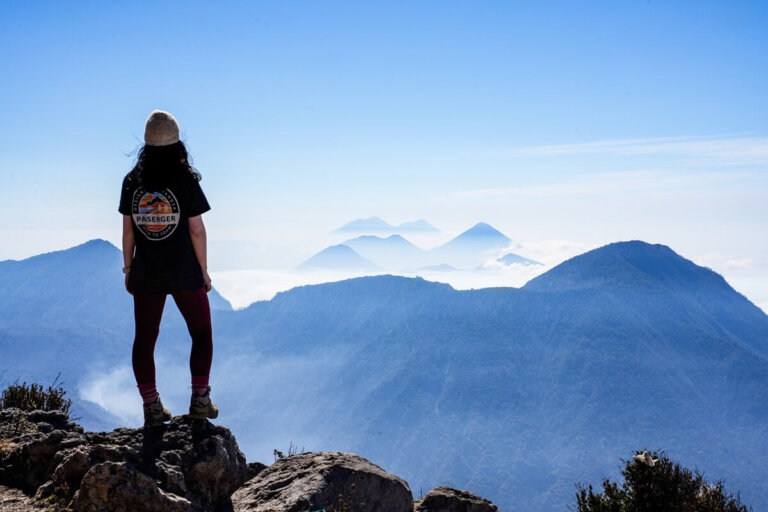Pacaya Volcano Hike in Guatemala – An Essential Guide
Volcan Pacaya is one of the 37 official volcanoes in Guatemala. In fact, it’s one of only 3 active volcanoes in the country. Thankfully, Pacaya Volcano is one of the most accessible volcanoes to hike and, due to its close proximity to Antigua, it’s also one of the most popular day trips from the city. Oh, and did we mention that you can roast marshmallows from the heat of the ground there?
Now, if that peaked your interest, then it’s time to dive into everything you should know about hiking Volcan Pacaya before you commit to doing it. Things like whether you’ll see red hot lava or not, or whether your marshmallows will be properly roasted or just a little warm. We want to give you the most realistic picture of what to expect, so that you can return to the beautiful colonial city of Antigua feeling fulfilled and not disappointed.
If you’d like to see our experience hiking Pacaya Volcano, then make sure to watch our dedicated Antigua video on our YouTube channel. For more Guatemala videos, you can also check out our Guatemala series.
Disclosure: This post may contain affiliate links, which means we may receive a small commission if you click a link and purchase something. Clicking these links won’t cost you anything, but it will help us to keep this site up and running! Learn more about our affiliate policy.

About Pacaya Volcano
Volcan Pacaya is located about 30km to the south of Guatemala City and to the southeast of the city of Antigua, within Parque Nacional Volcan de Pacaya. Pacaya is not only one of the 37 official volcanoes in Guatemala, but also one of only 3 active ones. The other two are Fuego, located near Antigua, and Santiaguito, located close to Xela (Quetzaltenango). Since it’s an active volcano, you can’t actually summit it.
It’s 2,552 m (8,373 ft) tall and was only formed about 23,000 years ago, making it ‘young’ in volcano terms. Since 1565 it has erupted at least 23 times. After being dormant for about 70 years it erupted without warning in 1961. Since then, Pacaya has been continuously erupting. There have been more active phases from 2006 onwards, during which time the volcano has generated lava flows. Some of the most recent eruptions happened in 2010 and 2021.
As you would imagine, once the lava started flowing Pacaya Volcano saw a surge in visitor numbers. If you had visited during this time, you would’ve seen red hot lava running down the volcano in channels and could’ve really roasted your marshmallows or cooked a pizza over it.
However, if you visit now in 2024, you’ll only see the dried up lava field. Of course, this didn’t take away from our experience, but if you’re expecting to see lava flowing because of photos you’ve seen online, then you’ll probably end up being a bit disappointed. Let’s also not forget that Pacaya is still active and could erupt again at any time in the future.
Practical Information Before Hiking Volcan Pacaya
Hiking Route Map
Pacaya Volcano Hike Stats:
- Trail length: 5 km / 3 miles (circular)
- Trailhead starts: San Francisco de Sales
- Trailhead ends: La Corona
- Summit of Payaca Volcano: 2,552 m / 8,373 ft
- Highest point along the hike: Cerro Chino at 2,300 m / 7,545 ft
- Elevation Gain: 350 m / 1,150 ft
- Level of Difficulty: Easy to Moderate
Why Should You Visit Pacaya Volcano with a Tour
If you’re a regular reader of our blog, then you probably know that we like to do things on our own. We normally only join an organised tour if a tour is necessary to visit a location, or if there’s no other transport option for reaching said destination.
To hike Pacaya Volcano, we decided to join an organised tour from Antigua. Here’s why:
- After researching how we could get to Pacaya Volcano by public transport, we came to the conclusion that whilst it’s possible to get there on chicken buses, in reality it would take hours and a few bus changes.
- Even if we’d chosen to get there by public transport, we couldn’t actually hike Pacaya Volcano without a guide.
So, it made more sense to join a tour from Antigua which included transportation and a guide who hiked with us.
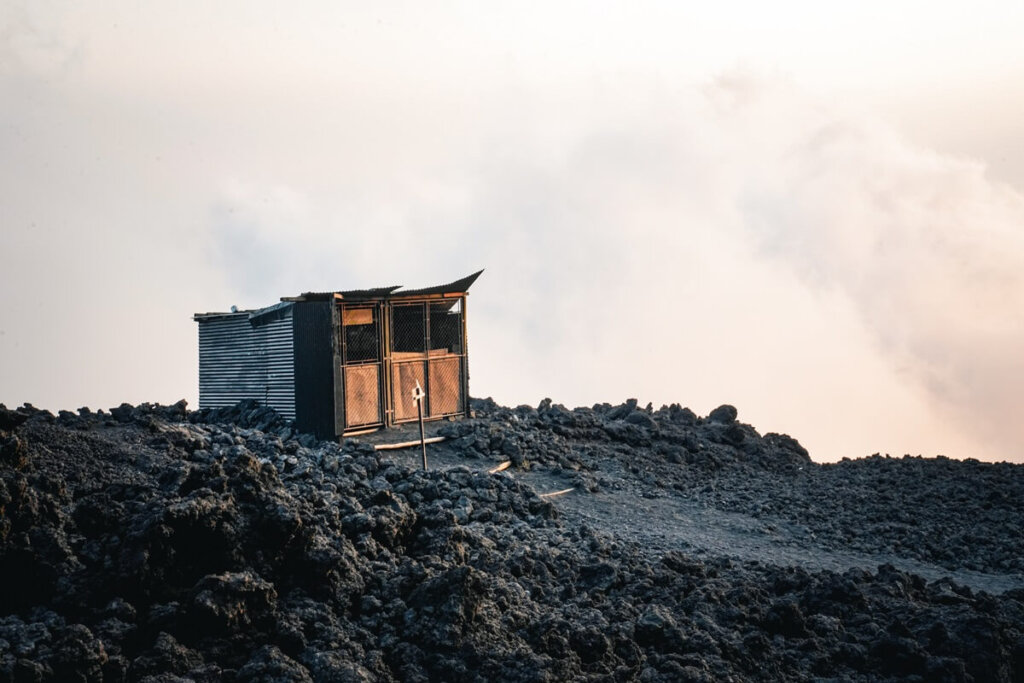
Best Tour Companies for Hiking Pacaya Volcano
Below are a few tour companies to consider for the Pacaya Volcano hike:
- OX Expeditions. They offer the half-day hike as well as the overnight hike experience. Based on the half-day hike description on their website they provide food as well as marshmallow roasting in the price. Check out their website here.
- CA Travelers. This agency offers the half-day (either morning or afternoon) hike to Pacaya volcano as well as shuttle services to places like Lake Atitlan and Lanquin. Check out their website here.
- Old Town Outfitters. They offer the half-day (either morning or afternoon) hike as well as a full day hike that includes a stop at some thermal pools. The company also offers a biking and camping tour too. Their overnight Pacaya Volcano tour is also available to book via Viator. Check out their official website here.
- Simoon Rentals & Tours. If you don’t want to hike, then this company offers an ATV tour. They also offer shuttle services to other destinations within Guatemala such as Lake Atitlan and Lanquin. Their Pacaya Volcano ATV tour is available to book via Get Your Guide.
You can browse for more tours either on Get Your Guide or Viator.
For reference, we went on CA Travelers’ sunset tour, which was reasonably priced and had good reviews on Google.
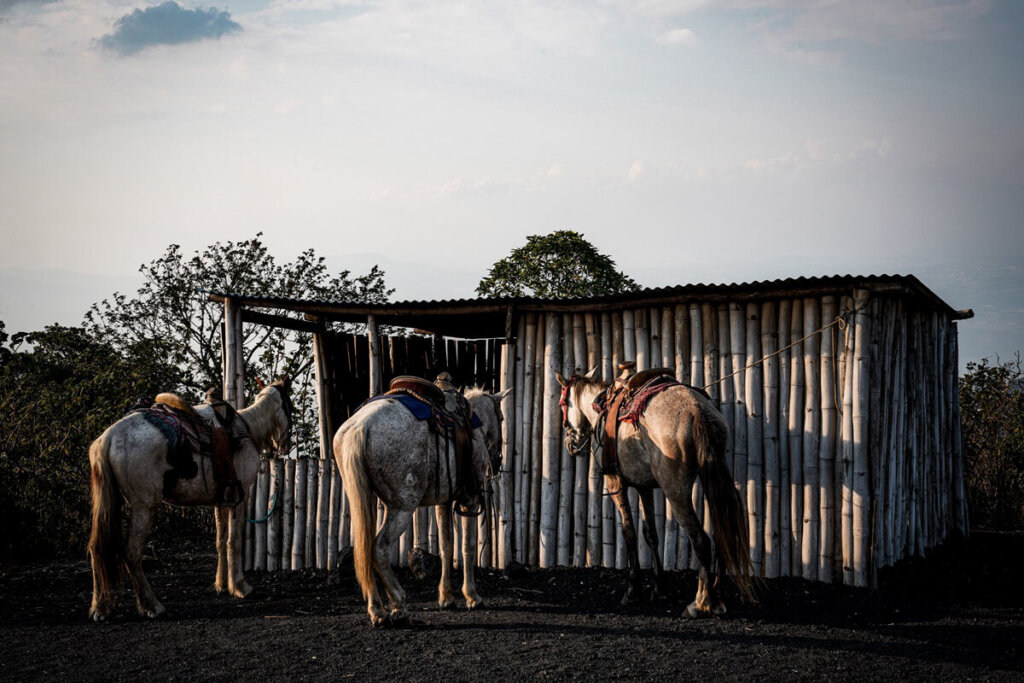
Cost of Hiking Volcan Pacaya
First of all, you’ll have to pay for your organised tour. The cost varies depending on which tour operator you choose. We paid Q150 per person for our tour with CA Travelers. The cost included our transport there and back, the tour guide, and some marshmallows to roast.
In addition, you’ll also be required to pay an entrance fee of Q100 to the national park. This is normally excluded from your tour price and can only be paid in cash on arrival.
As we got off the bus, young kids approached us offering walking sticks to rent. They were around Q10 per stick. Don’t forget to bring some extra cash with you to pay for a horse ride up if you think you might struggle to hike up to the viewpoint.
Whilst the organised tour price will include your local guide, it’s always good to have some extra cash with you for tips.
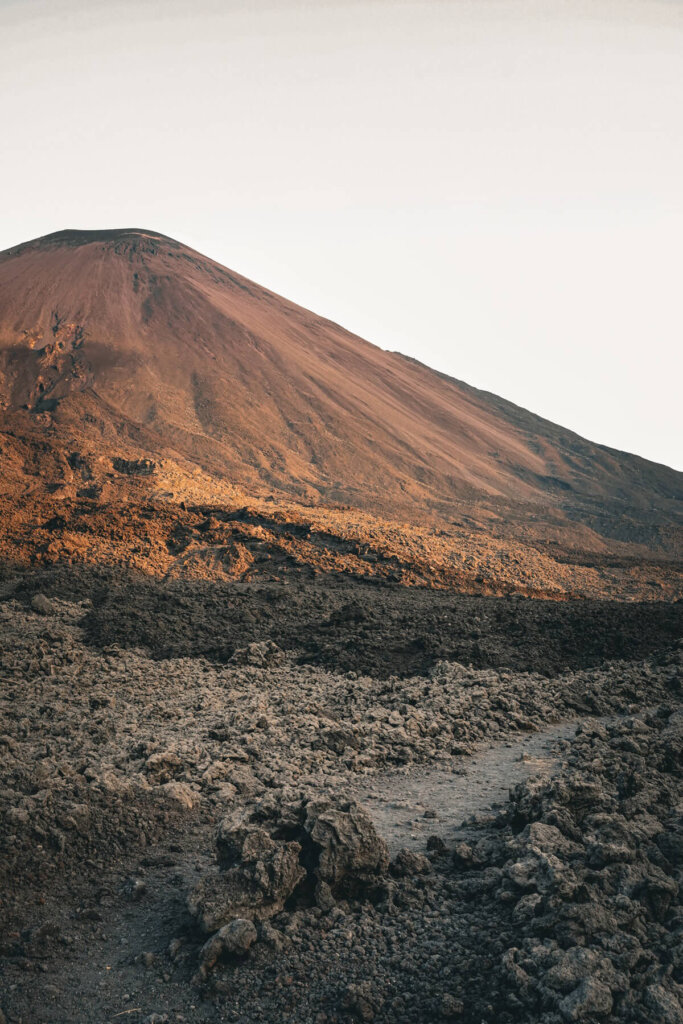

Best Time to Hike Volcan Pacaya
You can technically hike Pacaya Volcano all year round. Of course, the best time would be during the dry season, which is from November to April in Guatemala. This doesn’t mean that you can’t hike in the rainy season, but make sure to check the forecast. Normally, the mornings are fine with heavy rain in the afternoon.
In terms of time of day, most tours offer either a 6 AM / 8 AM start or a 2 PM start. Note that at neither of these times will you be able to see lava due to the lack of heightened volcanic activity since 2021. There are some companies that offer an overnight camping experience, which would have been pretty cool in our opinion. Perhaps if you stay overnight you may be able to see some lava, although we can’t say for certain as it would depend on the volcanic activity at the time of your visit.
Now, there are pros and cons to picking either the morning or afternoon hike. If you’re visiting in the dry or shoulder season, then doing the afternoon tour might be better. In the morning you would’ve already missed the sunrise and you’ll be hiking in the heat of the day. It can also get pretty hazy too.
In the afternoon, you’ll be hiking when it’s slightly cooler, although the start of the hike will still be hot, and then you’ll get to witness the sunset. During the rainy season the afternoons can be pretty cloudy, so we would probably pick the morning departure time.
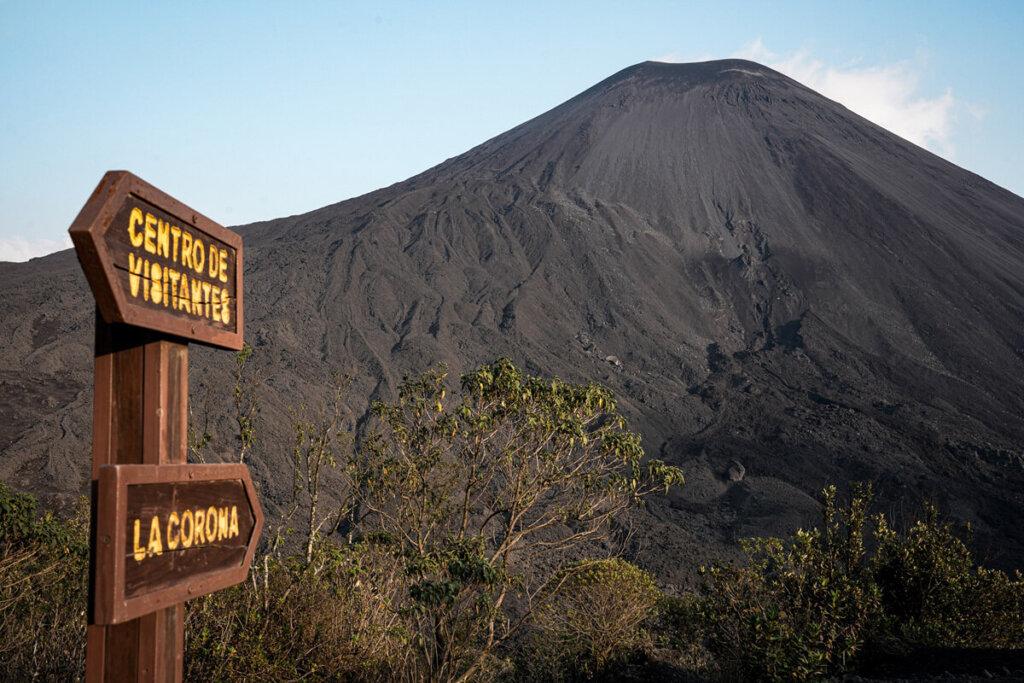
Length of the Pacaya Volcano Hiking Trail
There are two official entry / exit points to Pacaya Volcano. The most popular one is at San Francisco de Sales (located here on Google Maps). The other one is at La Corona (here on Google Maps).
Most tour groups start at San Francisco de Sales and finish at La Corona. The total length of this route is about 5 km (3 miles).
For the sunset hike, we set off at 4 PM after a nearly 2-hour drive from Antigua. We reached the main viewpoint around 5 PM. There, we had about 15-20 minutes of free time to enjoy the views. Then we took a short walk down to the lava fields and roasted our marshmallows around 5:30 PM. We got to the La Corona entry point around 6:15 PM. Then it took another hour and a half to get back to Antigua.
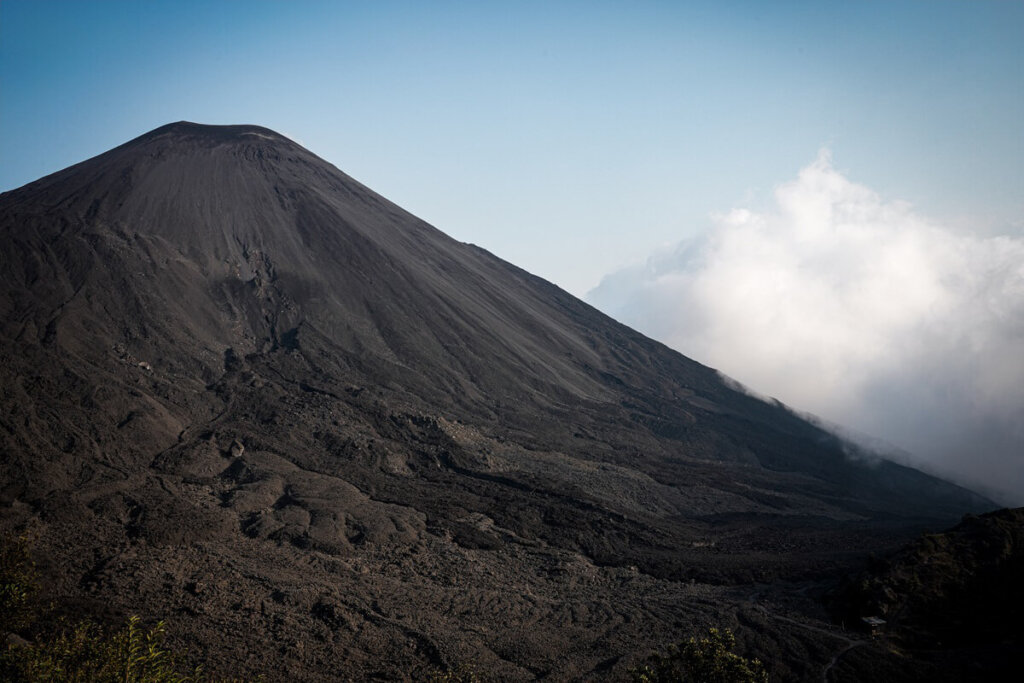
Level of Difficulty of the Pacaya Volcano Hike
Whilst some people (including us) would say hiking Payaca Volcano is easy, we would rate it as easy to moderate.
We’re both experienced hikers and have completed several challenging day and multi-day treks around the world, many of which were at high-altitude. So, based on our past hiking record, Pacaya was actually one of the easier volcano hikes we’ve done.
However, a lot of people would disagree with us and would – rightfully – say that it’s definitely more challenging than it’s being portrayed. If you don’t hike often, or you have a poor level of fitness, then there’s a chance you won’t think that it’s a walk in the park either.
The maximum altitude you’ll be going up to is around 2,300 m (7,545 ft) at Cerro Chino, which is just under the 2,500 m (8,000 ft) where altitude sickness can start to occur. However, thanks to the short but steep elevation gain of 350 m (1,150 ft), you may very well feel out of breath. If you’re not hydrating properly, you can start to feel a bit light-headed. For this reason, we recommend spending at least one full day in Antigua before hiking Pacaya Volcano.
Our group had pretty much all ages, including families with younger kids, teens and a group of 60+ ladies. Some people hired a horse straight away and some decided to hop on one along the way. We believe that some of the elderly ladies decided not to attempt the hike and turned back because we didn’t see them again until the end.
You can complete the Pacaya Volcano hike on horseback if you’re struggling. This comes with an additional cost of course, so bring enough cash with you just in case. Horses are offered at the trailhead before you set off but a few of the horsemen lead their horses behind the group in case someone decides they need a ‘four-legged-taxi’.
Facilities Along the Pacaya Volcano Hiking Trail
There were toilets at the entrance of San Francisco de Sales and then at the end at La Corona.
We recommend bringing enough water and some snacks with you for the hike. If you’re on the afternoon tour, definitely have a satiating lunch before you set off. Then, you can recharge by going out for dinner once you’re back in Antigua.
If you’re on the early morning hike, try to eat something before you leave, or at least bring some food with you.
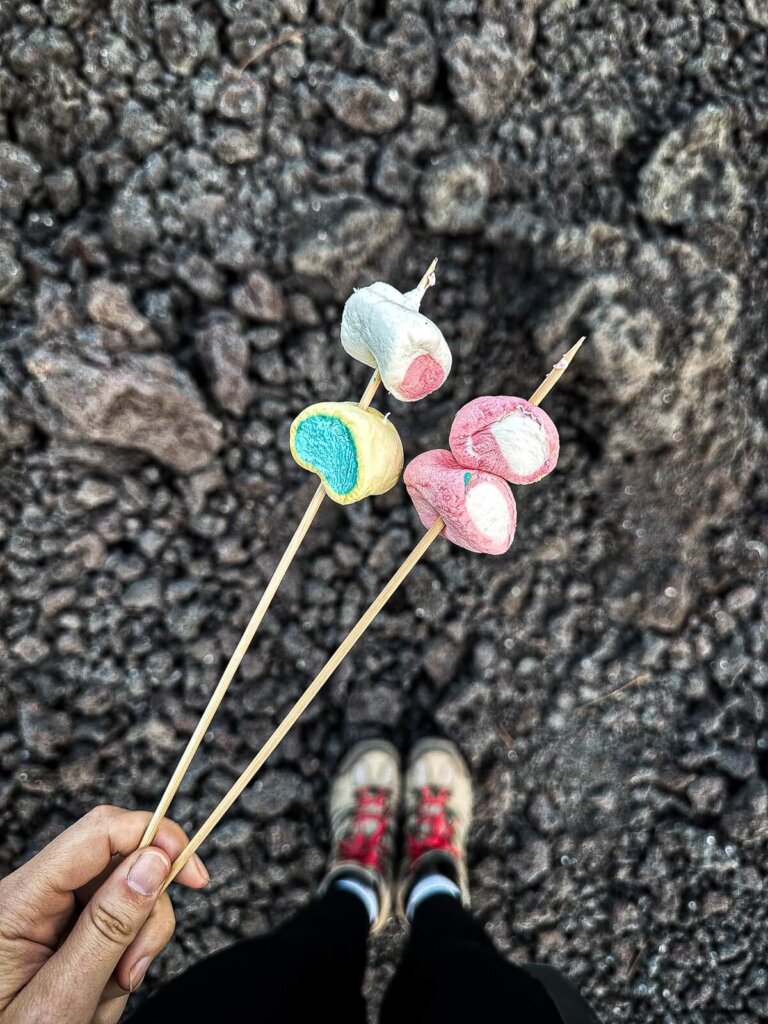
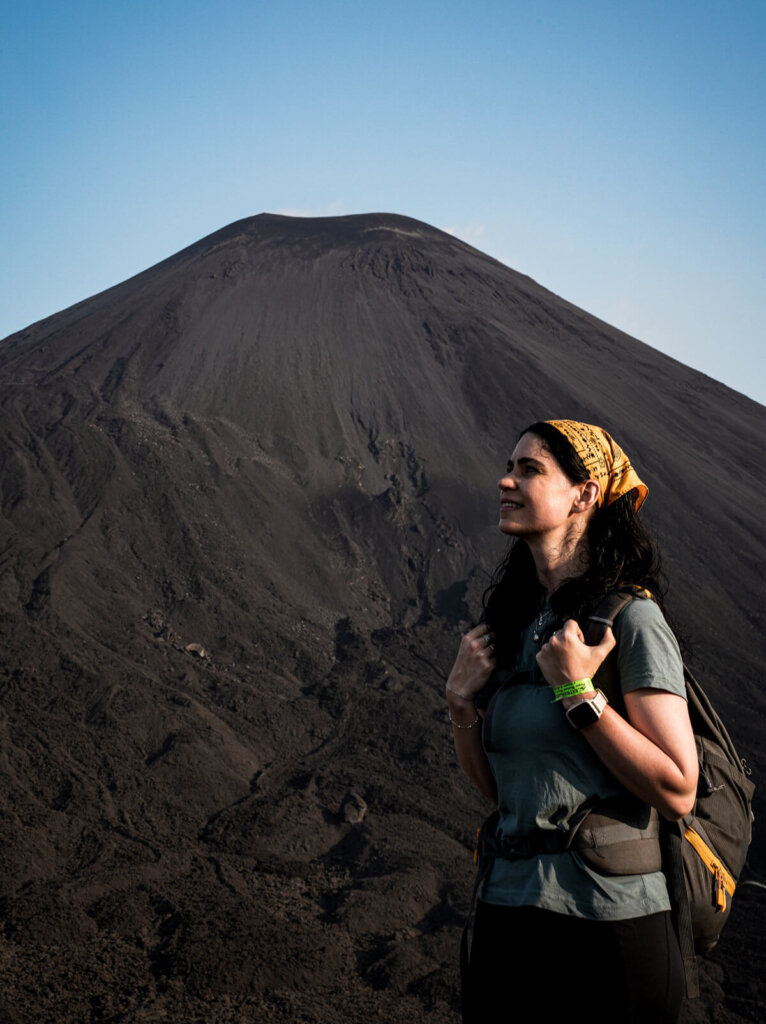
What to Wear and Bring with You for Hiking Pacaya Volcano
We highly recommend wearing outdoor and weather appropriate clothing when going on the Pacaya Volcano hike. It can be a bit chilly in the mornings and again in the evenings. However, in the dry season the temperatures increase quickly and it’ll still be pretty hot in the afternoon. Therefore, make sure to wear layers so you can adjust to the conditions. You can wear either shorts or long trousers depending on what you feel most comfortable in. We still suggest taking a fleece and / or a rain jacket, as it might be cooler on the top.
In terms of footwear, you should wear hiking boots or shoes with good grip. We personally like wearing boots for their extra ankle support, which comes in handy on the way down.
Also, make sure to have enough SPF on you as the sun can be pretty strong. Take a hat and sunglasses for extra protection as well. The trail is very dusty, so you may want to wear a bandana to cover your mouth and nose, especially during the descent. The horses also make the trail even more dusty.
The descent can be pretty hard on the knees, so you might want to use poles on the way down. As mentioned before, children will be selling sticks at the start of the hike if you don’t have hiking poles with you.
Most importantly, make sure to have plenty of drinking water to stay hydrated. A minimum of 1 L is recommended. Having some snacks is also a good idea to help re-fuel your body.
Have enough cash with you to cover your national park entry fee and a little extra for tips.
Do you Need Special Travel Insurance to Hike Pacaya Volcano
We cannot emphasize enough how important it is to have travel insurance before any trip you make abroad. Now, most travel insurance won’t automatically include cover for all the activities you’re planning on doing during your travels.
For example, if you’re visiting Guatemala, and are planning on hiking at high altitudes, then you should make sure to have cover for high altitude trekking in your insurance policy. Shop around to find the most suitable one. You just never know what could happen, and it’s better to be safe than sorry.
We personally use SafetyWing which covers trekking under 4,500m as standard and has an Adventure Sport add-on, which will then cover you up to 6,000m of elevation.
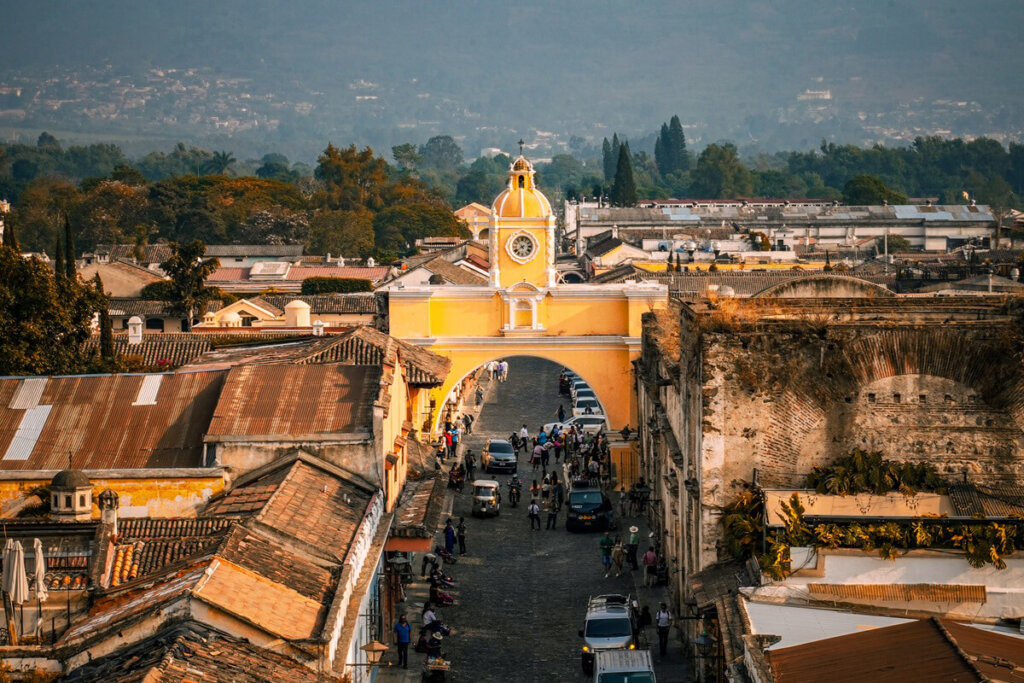
Pacaya Volcano Hiking Trail
1. Journey to Pacaya Volcano Trailhead
It takes about 1 hour and 30 minutes to get to the trailhead from Antigua with an organised tour. You’ll be picked up from your hotel, which is convenient but also comes with some cons.
You could easily be one of the first ones to be picked up but you could very well be the last one too. In the first case, you’d be circling around Antigua in the minivan for a good 30 minutes before everyone is on board. However, if you’re the last one, you could be waiting in front of your hotel for the same amount of time. You should really be ready at the time the tour operator tells you to be though because you don’t want to hold up the rest of the group and delay the tour.
We went on the sunset hike, and ended up stuck in traffic for an extra 20 minutes en-route. This meant that we had to hike faster and got to spend less time at the top.
Once you’ve made it to the trailhead, you’ll have to purchase your national park entry fee at the office. As you get off the minivan, kids will swarm you selling wooden walking sticks. You can buy one if you want to. Walking sticks can come in handy on the way down, especially if you have knee problems.
Here you can also use the toilet facilities, which we highly suggest taking advantage of.
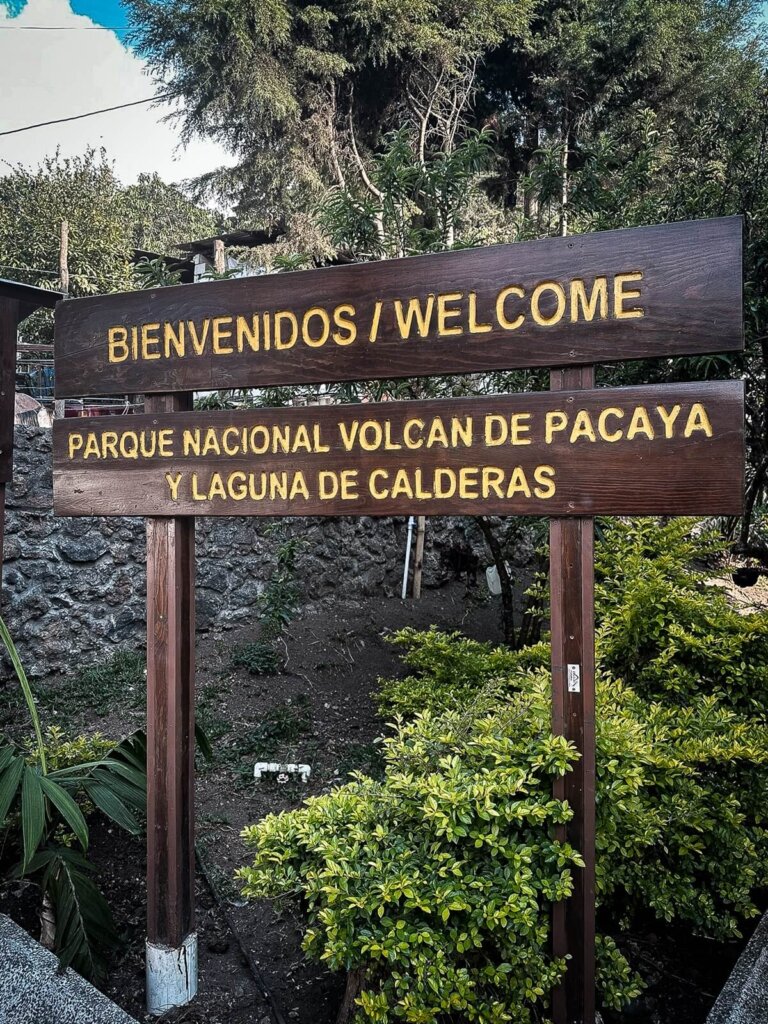
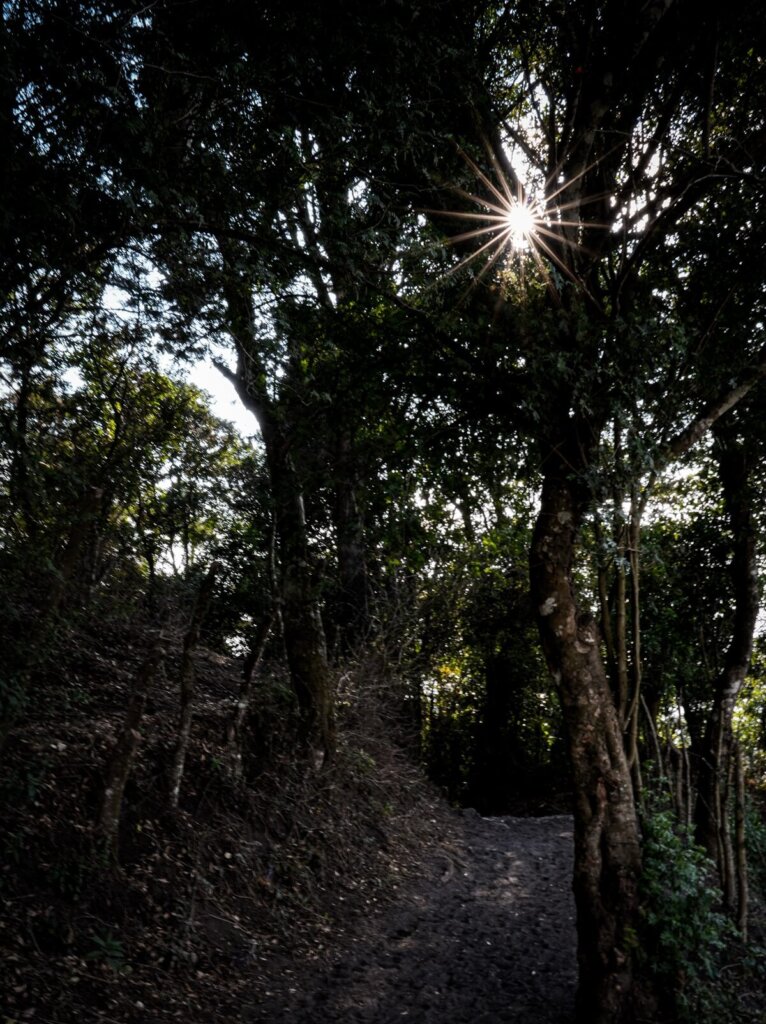
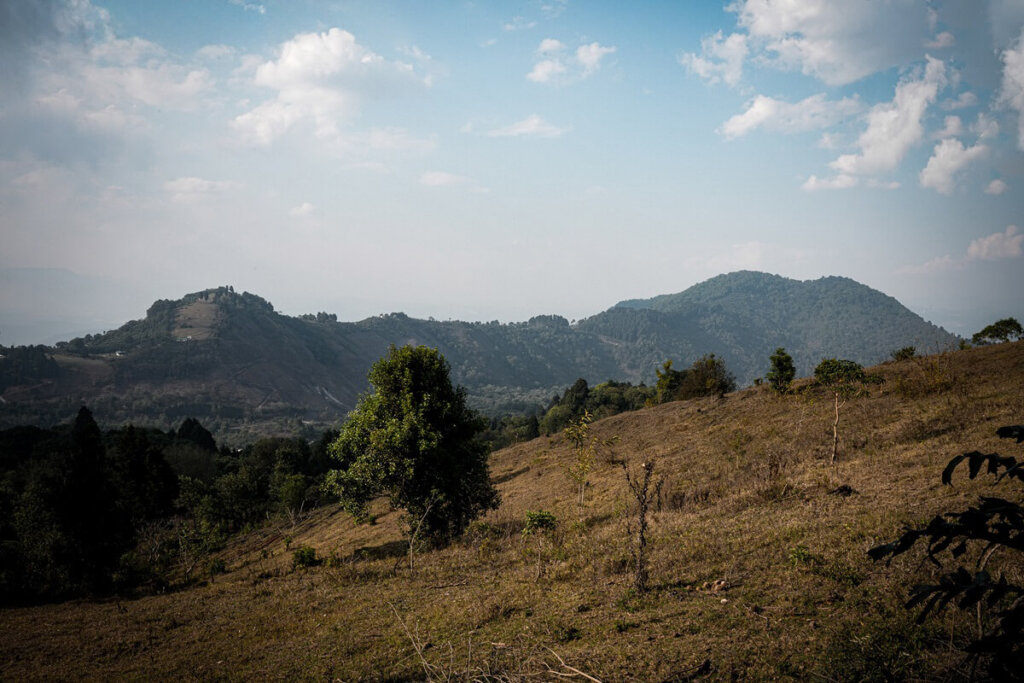
2. Trailhead to Cerro Chino (Pacaya Volcano Viewpoint)
Our guide talked us through the route briefly before we set off.
The path started off steep and was basically uphill the entire way until we reached Cerro Chino, aka the Pacaya Volcano Viewpoint. This section goes through the forest, so we at least had some shade from the strong afternoon sun.
Soon after setting off we reached the first rest area / viewpoint. It was a bit hazy, but on a clear day we could’ve seen Guatemala City in the distance. After catching our breath we carried on climbing higher. The next viewpoint was Mirador Majahue, from where we could’ve seen Volcan Agua, Acatenango and Fuego if it hadn’t have been too hazy.
Here our guide told us some more information about the volcanoes in Guatemala whilst we rehydrated and took a moment to rest. From here the path became even steeper. The group definitely started to split up more but our guide stopped often for breaks to try and keep the group together.
We were actually the last sunset group to leave the trailhead but ended up passing two other groups on the way up. We personally didn’t mind because it meant that we could spend slightly longer at the viewpoint.
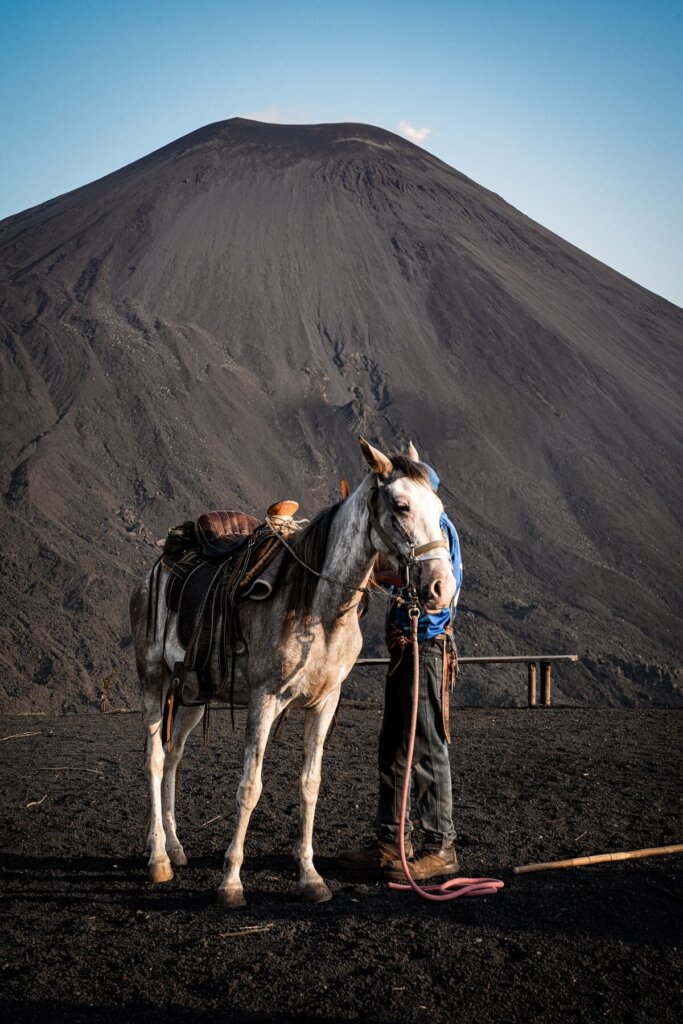
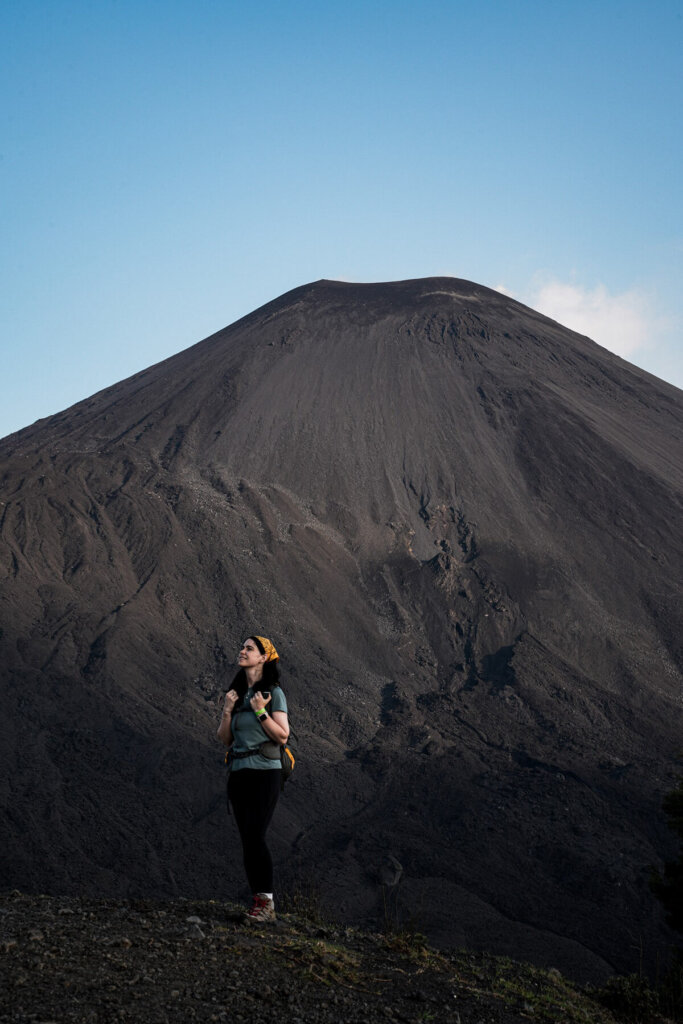
3. At Cerro Chino (Pacaya Volcano Viewpoint)
After emerging from the forest we reached a clearing with a fantastic view of Pacaya Volcano. Thankfully, the volcano was completely clear and we could even see it smoking slightly. Sometimes it can be in the clouds, so we considered ourselves very lucky to be able to see it in all its glory. The clouds were definitely threatening to roll in even during the short time we were up there.
On a clear day we could’ve also seen Volcan Agua from this vantage point, but it was a bit too hazy. We got a good 15 to 20 minutes here before our guide moved us on into the lava fields.
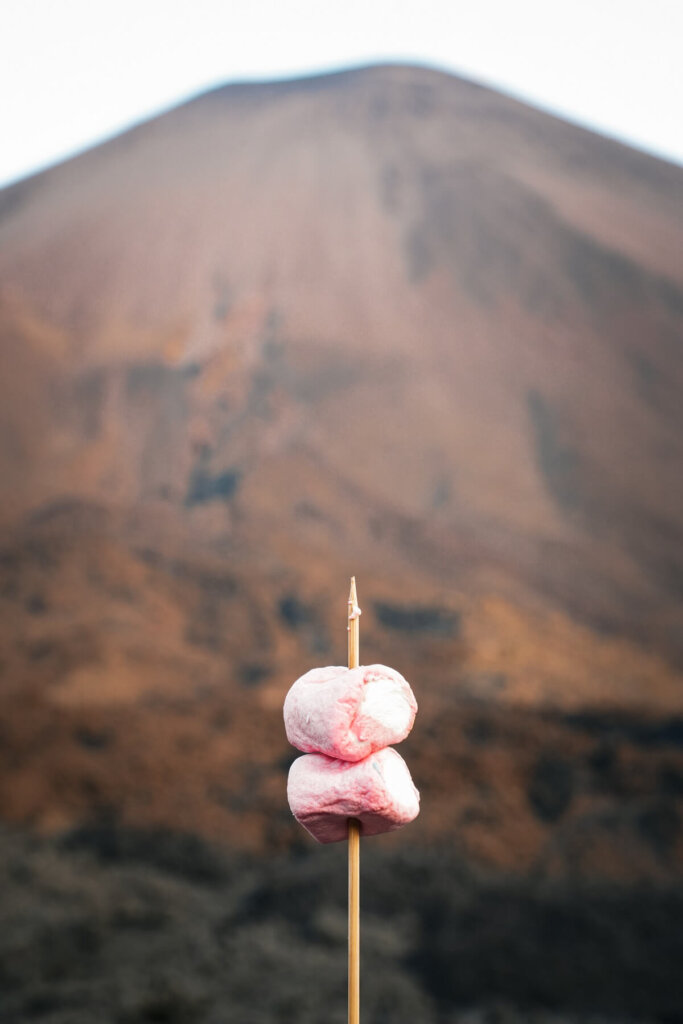
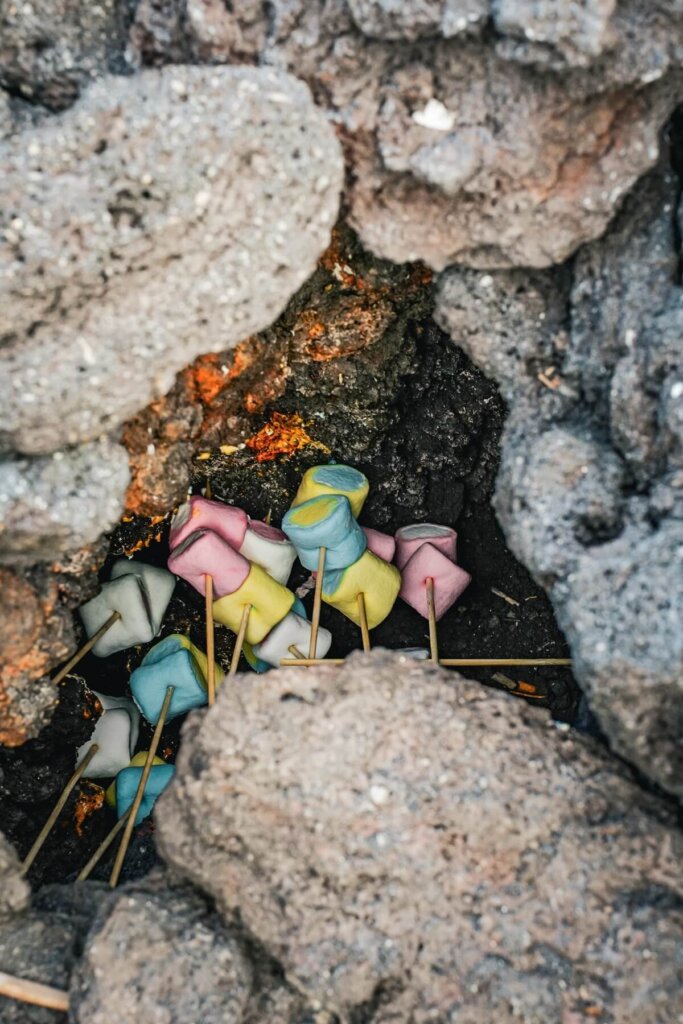
4. Roasting Marshmallows on the Lava Fields of Pacaya Volcano
We had a short but steep descent from the viewpoint to the lava field. Due to the lack of heightened volcanic activity at the time of our visit it wasn’t red hot, so we didn’t have to worry about our shoes melting. It was crazy to imagine what this area would’ve looked like during the eruption only a few years ago. Walking through the dry lava field here reminded us of our hike around Arenal Volcano in Costa Rica.
The guides picked a spot and started ‘roasting’ our marshmallows in the ground. Don’t expect your marshmallow to look very roasted though. It’ll be a bit warm and squishy but nothing like the ones you’d put on a S’more.
Regardless, it was still a fun experience to eat our marshmallows with views of an active volcano.
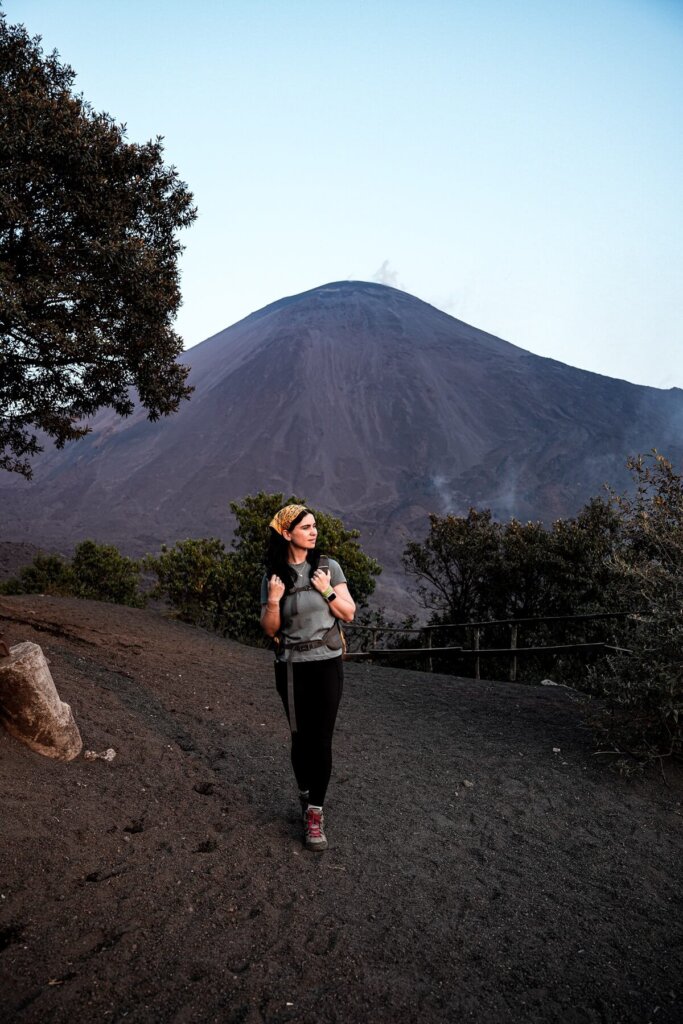
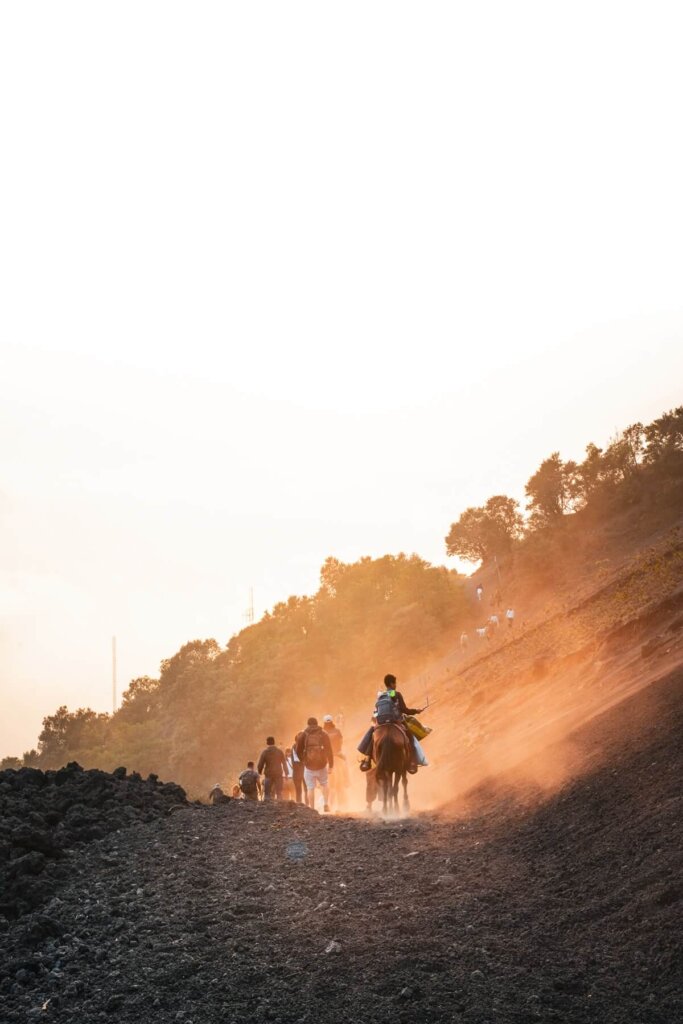
5. Descending Pacaya Volcano to La Corona
Once everyone had had their snack, we continued walking through the lava field. At this time the sun was starting to set, so the sky was really beautiful.
After stopping to watch the sunset, we started hiking down the volcano. The trail was very dusty all the way, so be ready for that. This is also when you may want to use a hiking pole. Once we reached La Corona, we said goodbye to our guide and had a chance to use the toilet facilities before hopping back into the minivan.
Summary of Things to Know Before You Hike Pacaya Volcano
- Pacaya is one of 3 active volcanoes in Guatemala, so you won’t be able to summit it.
- You cannot hike Pacaya without a guide.
- It’s far enough from Antigua that getting there with an organised tour makes more sense then trying to reach the site on public transport.
- You may see pictures of Pacaya with red hot lava flowing down it. These were taken when it last erupted in 2021, but in 2024 don’t expect to see lava.
- Whilst the hike is often labelled as easy, the ascent is very steep. So unless you’re an experienced hiker it won’t be a walk in the park.
- It’s a great acclimatisation hike, especially if you also want to complete the Acatenango / Fuego hike.
- If you’re struggling with the climb, you can request to hop on a horse for an additional cost.
- If you’re used to hiking at your own pace, you may feel either a bit rushed or like you’re going too slowly on this group hike.
- Toilets will only be available at the start and end of the hike.
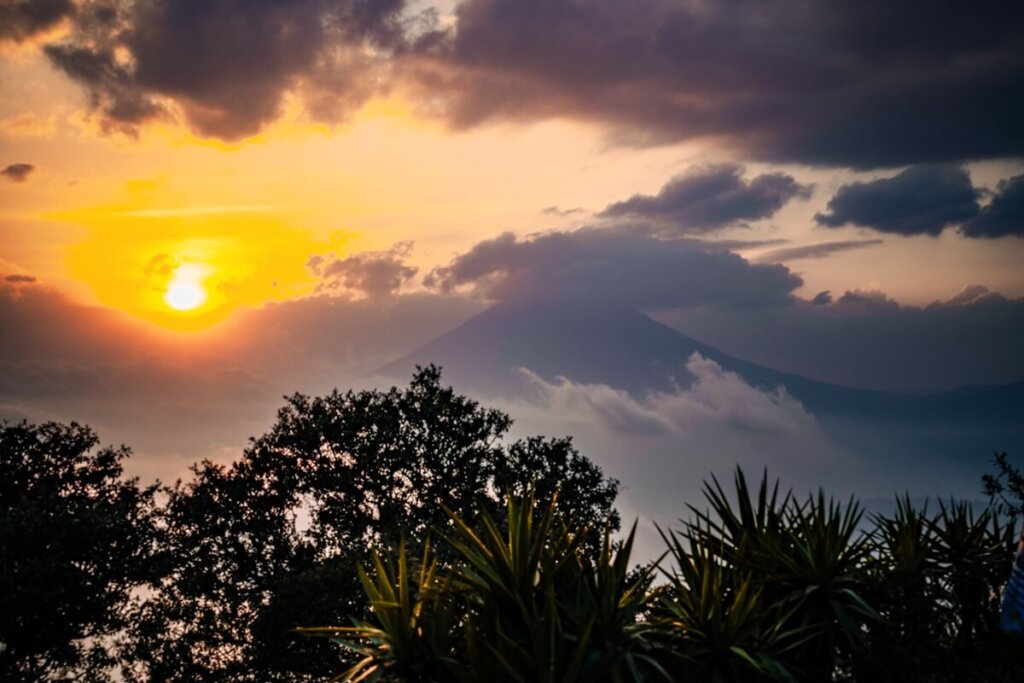
Final Thoughts on the Pacaya Volcano Hike
We mainly hiked Pacaya Volcano not just because we enjoy hiking, but also because we wanted to see all 3 active volcanoes in Guatemala. We summited the 3,772 m (12,375 ft) tall Volcan Santa Maria during our time in Xela, from where we could see Volcan Santiaguito erupting. Of course, we also completed the overnight Acatanengo hike from Antigua, from where we enjoyed spectacular views of Fuego erupting. So of course we couldn’t leave Guatemala without seeing Pacaya.
Whilst taking this tour did feel a little rushed, it was mainly because we were trying to take photos and videos and enjoy ourselves all at the same time. Thankfully, the volcano was clearly visible in the afternoon and we could also enjoy a lovely sunset, which definitely enhanced the overall experience.
Have you ever hiked Pacaya Volcano before? If yes, what was your experience like? If not, would you add this volcano hike to your Guatemala itinerary? Let us know in the comments below.

